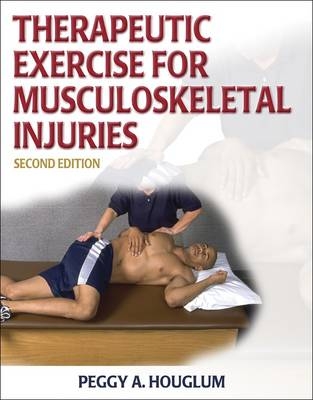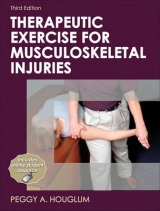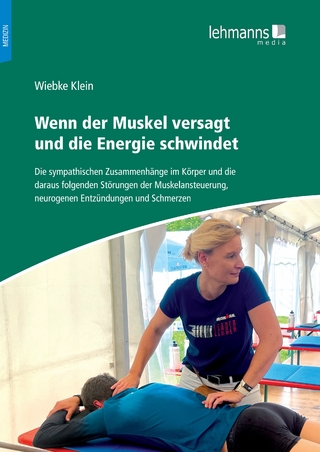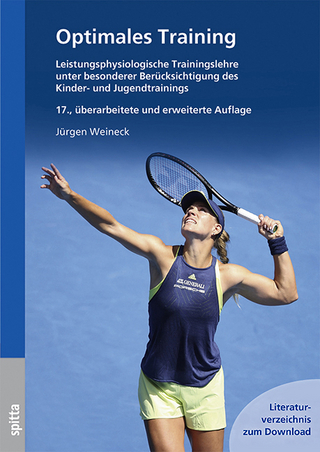
Therapeutic Exercise for Musculoskeletal Injuries
Human Kinetics Publishers (Verlag)
978-0-7360-5136-1 (ISBN)
- Titel erscheint in neuer Auflage
- Artikel merken
"Therapeutic Exercise for Musculoskeletal Injuries, Second Edition", formerly "Therapeutic Exercise for Athletic Injuries", will give you a thorough understanding of the science and application involved in creating superior therapeutic exercise programs. Updated and invigorated, the expansive text offers the most comprehensive approach available to therapeutic exercise. It is a major professional resource and the only text students need on the subject. "Therapeutic Exercise for Musculoskeletal Injuries, Second Edition", one of five texts in the "Athletic Training Education Series", helps readers develop a deeper understanding of the why, what, and when of therapeutic exercise techniques. It also presents the methodology for developing safe and effective therapeutic programs for the general population as well as individualized programs for specific audiences.
Updates to the new edition include the latest information on the regulations affecting the use of therapeutic exercise; a new section on Pilates; expanded coverage of isokinetics and PNF techniques; improved assessment techniques for the sacroilium; consideration of common conditions including facet impingement, spondylolisthesis, and glenoid labrum tear; and development of lab activities within the text. This comprehensive book is organized into 22 chapters and four parts, with each part building on the information from previous parts. Part I reviews important concepts related to rehabilitation. Part II covers therapeutic exercise parameters and techniques. Part III examines general therapeutic applications, and Part IV explores specific applications for therapeutic exercise. "Therapeutic Exercise for Musculoskeletal Injuries, Second Edition", is packed with useful elements to help students with different learning styles absorb, review, integrate, and apply the content. Among those elements are chapter objectives, practical scenarios, key points, key terms, sidebars, review questions, lab activities, references, and hundreds of photographs and illustrations.
Instructors will also find excellent supplemental materials, making planning and implementing the course easy, thus saving valuable time. These materials, including an instructor guide, test bank, and presentation package, are completely accessible online. "Athletic Training Education Series" contains five outstanding textbooks, each with its own supporting instructional resources. Featuring the work of respected athletic training authorities, the series was created to parallel and expound on the content areas within the accreditation standards of the Joint Review Committee on Educational Programs in Athletic Training (JRC-AT). This text addresses the JRC-AT standards domains of therapeutic exercise, pathology of injury and illness, assessment and evaluation, and psychosocial intervention and referral.
Peggy Houglum has more than 30 years of experience in rehabilitation providing patient and athlete care. Her extensive background as a certified athletic trainer and physiotherapist has provided her with a unique perspective on rehabilitation programmes that make therapeutic exercise techniques meaningful and appropriate for athletic injury treatment.
Part I: Basic ConceptsChapter 1. Concepts of Rehabilitation-The Roles of Rehabilitation Team Members-Interacting With Team Members-Qualities of Professionalism-Components of a Rehabilitation Program-Basic Components of Therapeutic Exercise-Return-to-Competition Criteria-Psychological Considerations-Summary-Critical Thinking Questions-Lab Activities-ReferencesChapter 2. Concepts of Healing-Primary and Secondary Healing-Healing Phases-Growth Factors-Healing of Specific Tissues-Tensile Strength during Healing-Factors That Affect Healing-The Role of Therapeutic Exercise in Healing-Summary-Critical Thinking Questions-Lab Activities-ReferencesChapter 3. Concepts in Physics-Force-Newton's Laws of Motion-Center of Gravity-Stability and Fixation-Body Levers-Levers and Force-Physiological Muscle Advantages-Other Concepts in Physics-Summary-Critical Thinking Questions-Lab Activities-Suggested ReadingChapter 4. Evaluation and Examination-Evaluation: Making a Profile-Assessment: Planning for Action-Keeping Rehabilitation Records-Summary-Critical Thinking Questions-Lab Activities-ReferencesPart II: Therapeutic Exercise Parameters and TechniquesChapter 5. Range of Motion and Flexibility-Defining Flexibility and Range of Motion-Connective-Tissue Composition-Effects of Immobilization on Connective Tissue-Effects of Remobilization on Connective Tissue-Mechanical Properties and Tissue Behavior in Range of Motion-Neuromuscular Influences on Range of Motion-Determining Normal Range of Motion-Measuring Range of Motion-Terminology in Goniometry-Stretching Techniques-Exercise Progression-Special Considerations-Summary-Critical Thinking Questions-Lab Activities-ReferencesChapter 6. Manual Therapy Techniques-Critical Analysis-Massage-Myofascial Release-Myofascial Trigger Points-Muscle Energy-Joint Mobilization-Neural Mobilization-Summary-Critical Thinking Questions-Lab Activities-References-Suggested ReadingChapter 7. Muscle Strength and Endurance-Muscle Structure and Function-Neuromuscular Physiology-Fast- and Slow-Twitch Fibers-Muscle Strength, Power, and Endurance-Force Production-Types of Muscle Activity-Open and Closed Kinetic Chain Activity-Evaluating Muscle Strength-Gradations of Muscle Activity-Strength Equipment-Proprioceptive Neuromuscular Facilitation-Strengthening Principles-Exercise Progression-Summary-Critical Thinking Questions-Lab Activities-ReferencesChapter 8. The ABCs of Proprioception-Neurophysiology of Proprioception-Central Nervous System Proprioceptor Sites-Balance-Coordination-Agility-Therapeutic Exercise for Proprioception-Summary-Critical Thinking Questions-Lab Activities-ReferencesChapter 9. Plyometrics-Neuromuscular Principles-Plyometric Force Production-Plyometric Exercise Phases-Pre-Plyometric Considerations-Plyometric Program Design-Plyometric Program Considerations-Precautions and Contraindications-Equipment-Lower-Extremity Plyometrics-Upper-Extremity and Trunk Plyometrics-Summary-Critical Thinking Questions-Lab Activities-ReferencesChapter 10. Functional Exercise-Definitions, Foundations, and Goals-Contributions to Therapeutic Exercise-Basic Functional Activities-Advanced Functional Activities-Advanced Functional Exercise Progression-Precautions-Functional Evaluation-A Lower-Extremity Functional Progression-An Upper-Extremity Functional Progression-Returning the Patient to Full Participation-Summary-Critical Thinking Questions-Lab Activities-Suggested ReadingPart III: General Therapeutic Exercise ApplicationsChapter 11. Posture and Body Mechanics-Posture-Muscle Imbalances-Body Mechanics-Body-Awareness Programs-Summary-Critical Thinking Questions-Lab Activities-References-Suggested ReadingChapter 12. Ambulation and Ambulation Aids-Normal Gait-Pathological Gait-Normal Running Gait-Mechanics of Ambulation with Assistive Devices-Summary-Critical Thinking Questions-Lab Activities-ReferencesChapter 13. Aquatic Therapeutic Exercise-Physical Properties and Principles of Water-Equipment-Indications, Advantages, Precautions, and Contraindications-Aquatic Therapeutic Exercise Principles and Guidelines-Deep-Water Exercise-Aquatic Therapeutic Exercises-Summary-Critical Thinking Questions-Lab Activities-ReferencesChapter 14. Swiss Balls and Foam Rollers-Swiss Balls-Swiss-Ball Exercises-Foam Rollers-Foam-Roller Exercises-Summary-Critical Thinking Questions-Lab Activities-Reference-Suggested ReadingChapter 15. Therapeutic Exercise for Tendinitis-Terminology-Tendon Structure-Etiology-Tendon Response-General Treatment-Specific Treatment-Examples of Tendinitis Cases-Summary-Critical Thinking Questions-Lab Activities-ReferencesPart IV: Specific ApplicationsChapter 16. Spine and Sacroiliac-General Rehabilitation Considerations-Soft-Tissue Mobilization -Joint Mobilization-Flexibility Exercises-Posture and Pelvic Stabilization Exercises-Strengthening Exercises-Agility and Coordination Exercises-Special Rehabilitation Applications-Summary-Critical Thinking Questions-Lab Activities-References-Suggested ReadingChapter 17. Shoulder and Arm-Mechanics of Overhead Sport Activities-General Rehabilitation Considerations-Soft-Tissue Mobilization -Joint Mobilization-Flexibility Exercises-Strengthening Exercises-Stabilization Exercises-Plyometric Exercises-Functional Activities-Special Rehabilitation Applications-Summary-Critical Thinking Questions-Lab Activities-References-Suggested ReadingChapter 18. Elbow and Forearm-General Rehabilitation Considerations-Soft-Tissue Mobilization -Joint Mobilization-Flexibility Exercises-Strengthening Exercises-Functional Activities-Special Rehabilitation Applications-Summary-Critical Thinking Questions-Lab Activities-References-Suggested ReadingChapter 19. Wrist and Hand-General Rehabilitation Considerations-Soft-Tissue Mobilization-Joint Mobilization-Flexibility Exercises-Strengthening Exercises-Plyometric Exercises-Functional Activities-Special Rehabilitation Applications -Summary-Critical Thinking Questions-Lab Activities-References-Suggested ReadingChapter 20. Foot, Ankle, and Lower Leg-General Rehabilitation Considerations-Common Structural Deformities-Orthotic Treatment for Foot Deformities-Determining Proper Footwear for Patients-Soft-Tissue Mobilization-Deep-Tissue Massage-Joint Mobilization-Flexibility Exercises-Strengthening Exercises-Proprioceptive Exercises-Functional Exercises-Special Rehabilitation Applications-Summary-Critical Thinking Questions-Lab Activities-References-Suggested ReadingChapter 21. Knee and Thigh-General Rehabilitation Considerations-Soft-Tissue Mobilization-Joint Mobilization-Flexibility Exercises-Strengthening Exercises-Proprioceptive Exercises-Functional Exercises-Special Rehabilitation Applications -Summary-Critical Thinking Questions-Lab Activities-ReferencesChapter 22. Hip-General Rehabilitation Considerations-Soft-Tissue Mobilization-Joint Mobilization-Flexibility Exercises-Strengthening Exercises-Proprioceptive Exercises-Functional Exercises-Special Rehabilitation Applications -Summary-Critical Thinking Questions-Lab Activities-References
| Erscheint lt. Verlag | 7.1.2005 |
|---|---|
| Zusatzinfo | 247 black & white illustrations, 247 colour illustrations, 945 black & white halftones |
| Verlagsort | Champaign |
| Sprache | englisch |
| Maße | 216 x 279 mm |
| Themenwelt | Medizin / Pharmazie ► Medizinische Fachgebiete ► Sportmedizin |
| Medizin / Pharmazie ► Physiotherapie / Ergotherapie | |
| ISBN-10 | 0-7360-5136-8 / 0736051368 |
| ISBN-13 | 978-0-7360-5136-1 / 9780736051361 |
| Zustand | Neuware |
| Haben Sie eine Frage zum Produkt? |
aus dem Bereich



